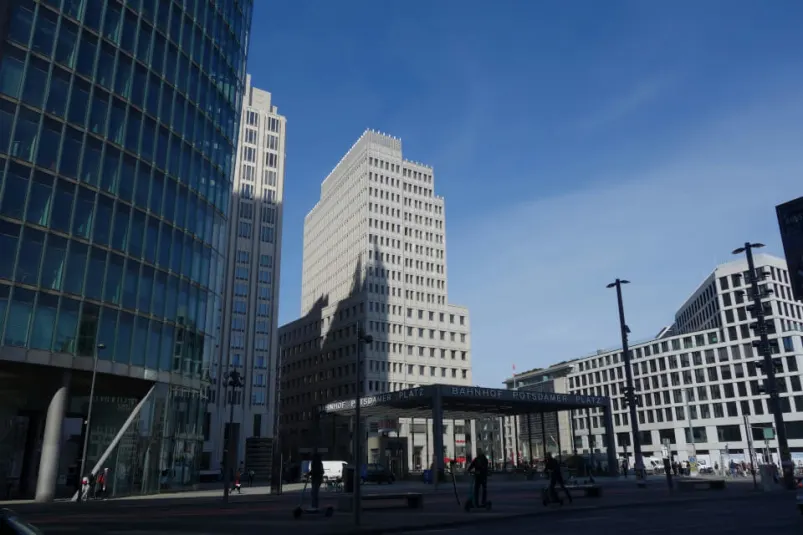Potsdamer Platz in Berlin: exciting history since 1838

Between the wounds of World War II and the vision of a cosmopolitan city - Potsdamer Platz tells the story of Berlin like no other place. It has been a traffic junction, a ruin, a no-man's land and then a shining example of urban renewal.
And today? A place where tourists take photos every minute, bus groups pass through and Berliners either enthuse or complain. Here, past and present merge in the smallest of spaces - not always silently, but always with effect.
From the first train station to the transportation hub - how it all began in 1838
The square was born at a time when Berlin was in the process of peeling itself out of its baroque Prussian skin. 1838 saw the inauguration of Potsdam station, the first long-distance railway station in Prussia. Trains rattled from here to Potsdam - a short distance, but a giant step towards modernity. What began as a technical innovation soon attracted urban life like a magnet. Street crossings, horse-drawn trolleybuses, gas lanterns and the first cafés formed the breeding ground for what would later become an urban legend. The atmosphere was electrifying: anyone who was out and about here moved to the beat of a city that never stood still. Whether in the theater, in a car or in a coffee house - the square connected social classes and lifestyles like no other.
Towards the end of the 19th century, the square was already one of the busiest places in the capital. Pedestrians, carriages and the first electric streetcars crossed each other every minute. The traffic density was so high that Europe's first traffic lights were installed here in 1924 - a six-sided traffic light system based on the New York model.
The square was lively, noisy and flooded with light. At night, neon signs shone over Café Josty, movie theaters courted premiere audiences and international society stayed in the neighboring Grand Hotel.
Between rubble and division - Potsdamer Platz in the shadow of the Wall
The great promise of the interwar period was brought to an abrupt end by the nights of bombing during the Second World War. Potsdamer Platz was almost completely destroyed. What remained were burnt-out facades, shattered rails and empty window cavities.
In the post-war period, the place lay fallow, shattered by the borders of the four sectors into which Berlin was divided. Later, the Wall ran along here and the heart of the city was amputated. For decades, the area remained a scar on the cityscape - openly visible and yet immovable.
What was once a traffic junction became a lifeless periphery. Closed off, monitored and surrounded by concrete, the square remained a place of stagnation. The emptiness had its own attraction - artists staged performances on wasteland, photographers documented the silent dreariness. Even Berliners avoided the place or used it as a shortcut without a destination. No café, no kiosk, no street - Potsdamer Platz had fallen off the map and yet continued to exist as an idea.
Reconstruction with daring - how the wasteland became a project for the future
The fall of the Berlin Wall in 1989 marked the hour of the urban planners. What had been a gaping wound for decades now became the focus of architects, investors and political visionaries. The area at Potsdamer Platz became a testing ground for the question of what modern cities should look like - and how they should be reassembled in the first place. No post-war romanticism, no reconstruction of the old magnificent buildings, but a design for the Berlin of tomorrow.
In the 1990s, new buildings, road axes and squares were built here at an enormous pace. Daimler-Benz, Sony and other large corporations invested billions. High-rise buildings sprang up, shopping arcades were opened, an entire district was designed - on drawing boards and computer screens, but with real concrete and steel.
Renzo Piano created urban ensemble spaces with an Italian signature, Helmut Jahn was responsible for the futuristic Sony Center. Today's skyline reads like an architectural guide to postmodernism.
Today an urban center - why the square is a magnet for tourists
In the meantime, the square has become like a well-curated theater stage. There is the spectacular roof of the Sony Center, which stretches over the Forum like a digital canopy. This is where films are shown, premieres take place, people meet, dine and stroll.
Opposite, the Kollhoff Tower rises up, from whose viewing platform Berlin can be viewed as if on a play mat. And at street level, there is a mixture of everyday life, excitement and postcard romance.
Culturally, the area is closely interwoven with the Berlinale, whose main venue is the Theater am Potsdamer Platz. The now closed film museum with original costumes, props and moving stories illustrates how closely the square is linked to film culture. Right next door: shopping opportunities, international restaurants, smaller stages and the Legoland Discovery Center for families.
The square has learned to offer itself without pandering. Its character is difficult to define - half boulevard, half business district, half backdrop. It is precisely this ambiguity that makes it so exciting for visitors. Nobody really knows what the square actually wants to be, and that is precisely what makes it typical of Berlin.
What makes Potsdamer Platz so special
Not far away, embedded metal plates mark the former course of the Wall, and individual original segments stand as memorials next to the new buildings. It is a juxtaposition of past and future, of architecture and memory, of concrete and meaning. This is also what makes the square so special: It sometimes seems too new, too smooth, too planned - and yet it breathes history. If you take your time, you will discover a mosaic of stories beneath the glass surface that continue to be written today.

Berlin Poche
Editorial Team
Always looking for new addresses, we like to share our discoveries and make you discover the best places in Berlin.